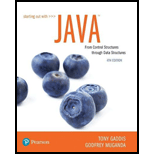
EBK STARTING OUT W/JAVA:...DATA...
4th Edition
ISBN: 9780134757179
Author: GADDIS
Publisher: PEARSON CO
expand_more
expand_more
format_list_bulleted
Concept explainers
Expert Solution & Answer
Chapter 16.3, Problem 16.17CP
Explanation of Solution
To prove:
Every function in
Proof:
Assume
So that the positive value of “K” such that
Expert Solution & Answer
Want to see the full answer?
Check out a sample textbook solution
Students have asked these similar questions
"Do not use AI tools. Solve the problem by hand on paper only and upload a photo of your handwritten solution."
| √ (r² + r + 1)e^ dr
Ensure you answer the question asked at the end of the document. Do not just paste things without the GNS3 console outputs
Chapter 16 Solutions
EBK STARTING OUT W/JAVA:...DATA...
Ch. 16.1 - Prob. 16.1CPCh. 16.1 - Prob. 16.2CPCh. 16.1 - Prob. 16.3CPCh. 16.1 - Prob. 16.4CPCh. 16.2 - Prob. 16.5CPCh. 16.2 - Prob. 16.6CPCh. 16.2 - Prob. 16.7CPCh. 16.2 - If a sequential search is performed on an array,...Ch. 16.3 - Prob. 16.9CPCh. 16.3 - Prob. 16.10CP
Ch. 16.3 - Prob. 16.11CPCh. 16.3 - Prob. 16.12CPCh. 16.3 - Prob. 16.13CPCh. 16.3 - Prob. 16.14CPCh. 16.3 - Let a[ ] and b[ ] be two integer arrays of size n....Ch. 16.3 - Prob. 16.16CPCh. 16.3 - Prob. 16.17CPCh. 16.3 - Prob. 16.18CPCh. 16 - Prob. 1MCCh. 16 - Prob. 2MCCh. 16 - Prob. 3MCCh. 16 - Prob. 4MCCh. 16 - Prob. 5MCCh. 16 - Prob. 6MCCh. 16 - Prob. 7MCCh. 16 - Prob. 8MCCh. 16 - Prob. 9MCCh. 16 - Prob. 10MCCh. 16 - True or False: If data is sorted in ascending...Ch. 16 - True or False: If data is sorted in descending...Ch. 16 - Prob. 13TFCh. 16 - Prob. 14TFCh. 16 - Assume this code is using the IntBinarySearcher...Ch. 16 - Prob. 1AWCh. 16 - Prob. 1SACh. 16 - Prob. 2SACh. 16 - Prob. 3SACh. 16 - Prob. 4SACh. 16 - Prob. 5SACh. 16 - Prob. 6SACh. 16 - Prob. 7SACh. 16 - Prob. 8SACh. 16 - Prob. 1PCCh. 16 - Sorting Objects with the Quicksort Algorithm The...Ch. 16 - Prob. 3PCCh. 16 - Charge Account Validation Create a class with a...Ch. 16 - Charge Account Validation Modification Modify the...Ch. 16 - Search Benchmarks Write an application that has an...Ch. 16 - Prob. 8PCCh. 16 - Efficient Computation of Fibonacci Numbers Modify...
Knowledge Booster
Learn more about
Need a deep-dive on the concept behind this application? Look no further. Learn more about this topic, computer-science and related others by exploring similar questions and additional content below.Similar questions
- "Do not use AI tools. Solve the problem by hand on paper only and upload a photo of your handwritten solution."arrow_forward"Do not use AI tools. Solve the problem by hand on paper only and upload a photo of your handwritten solution."arrow_forward"Do not use AI tools. Solve the problem by hand on paper only and upload a photo of your handwritten solution."arrow_forward
- "Do not use AI tools. Solve the problem by hand on paper only and upload a photo of your handwritten solution."arrow_forwardSolve this "Do not use AI tools. Solve the problem by hand on paper only and upload a photo of your handwritten solution."arrow_forward"Do not use AI tools. Solve the problem by hand on paper only and upload a photo of your handwritten solution."arrow_forward
- "Do not use AI tools. Solve the problem by hand on paper only and upload a photo of your handwritten solution."arrow_forwardSpecifications: Part-1Part-1: DescriptionIn this part of the lab you will build a single operation ALU. This ALU will implement a bitwise left rotation. Forthis lab assignment you are not allowed to use Digital's Arithmetic components.IF YOU ARE FOUND USING THEM, YOU WILL RECEIVE A ZERO FOR LAB2!The ALU you will be implementing consists of two 4-bit inputs (named inA and inB) and one 4-bit output (named out). Your ALU must rotate the bits in inA by the amount given by inB (i.e. 0-15).Part-1: User InterfaceYou are provided an interface file lab2_part1.dig; start Part-1 from this file.NOTE: You are not permitted to edit the content inside the dotted lines rectangle. Part-1: ExampleIn the figure above, the input values that we have selected to test are inA = {inA_3, inA_2, inA_1, inA_0} = {0, 1, 0,0} and inB = {inB_3, inB_2, inB_1, inB_0} = {0, 0, 1, 0}. Therefore, we must rotate the bus 0100 bitwise left by00102, or 2 in base 10, to get {0, 0, 0, 1}. Please note that a rotation left is…arrow_forwardSolve this "Do not use AI tools. Solve the problem by hand on paper only and upload a photo of your handwritten solution."arrow_forward
- Solve this "Do not use AI tools. Solve the problem by hand on paper only and upload a photo of your handwritten solution."arrow_forward"Do not use AI tools. Solve the problem by hand on paper only and upload a photo of your handwritten solution."arrow_forwardSolve this "Do not use AI tools. Solve the problem by hand on paper only and upload a photo of your handwritten solution."arrow_forward
arrow_back_ios
SEE MORE QUESTIONS
arrow_forward_ios
Recommended textbooks for you
 Operations Research : Applications and AlgorithmsComputer ScienceISBN:9780534380588Author:Wayne L. WinstonPublisher:Brooks Cole
Operations Research : Applications and AlgorithmsComputer ScienceISBN:9780534380588Author:Wayne L. WinstonPublisher:Brooks Cole C++ for Engineers and ScientistsComputer ScienceISBN:9781133187844Author:Bronson, Gary J.Publisher:Course Technology Ptr
C++ for Engineers and ScientistsComputer ScienceISBN:9781133187844Author:Bronson, Gary J.Publisher:Course Technology Ptr C++ Programming: From Problem Analysis to Program...Computer ScienceISBN:9781337102087Author:D. S. MalikPublisher:Cengage Learning
C++ Programming: From Problem Analysis to Program...Computer ScienceISBN:9781337102087Author:D. S. MalikPublisher:Cengage Learning

Operations Research : Applications and Algorithms
Computer Science
ISBN:9780534380588
Author:Wayne L. Winston
Publisher:Brooks Cole

C++ for Engineers and Scientists
Computer Science
ISBN:9781133187844
Author:Bronson, Gary J.
Publisher:Course Technology Ptr

C++ Programming: From Problem Analysis to Program...
Computer Science
ISBN:9781337102087
Author:D. S. Malik
Publisher:Cengage Learning